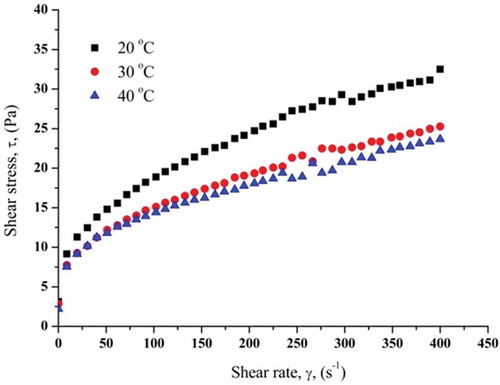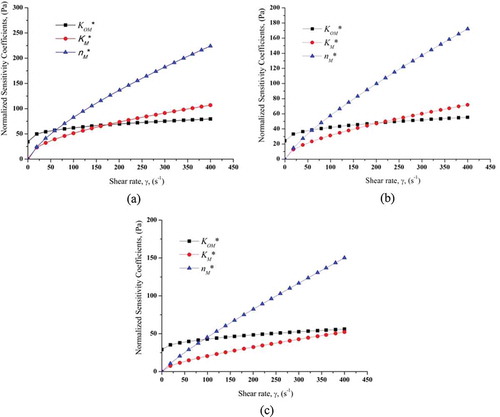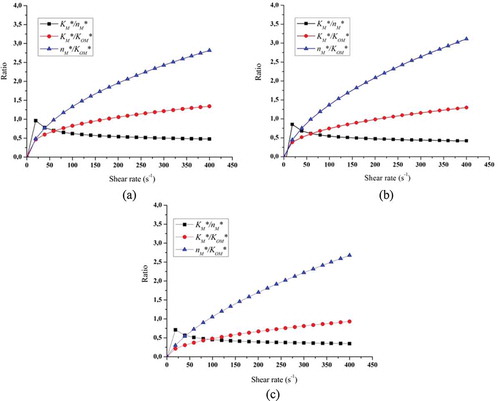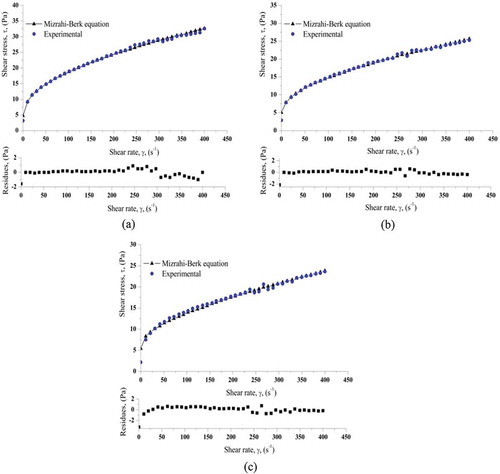ABSTRACT
All liquid products derived from fruit are biphasic systems composed of solid particles dispersed in an aqueous medium. Some exhibit Newtonian behaviour, but most of them display pseudoplastic behaviour; sometimes it shows initial flow resistance and/or time-dependent flow. This article presents a solution of an inverse problem to estimate the rheological properties of mango pulp (Mangifera indica). The direct problem was solved using the Mizrahi–Berk equation with three parameters to determine the consistency index (KM), the fluid behaviour index (nM), and the square root of yield stress (KOM). The objective was to determine the rheological properties of mango pulp by solving an inverse problem with parameter estimated using the Levenberg–Marquardt method. The inverse method provided accurate estimations of the rheological parameters, considering that the experimental and theoretical residual shear stress curves were quite small.
Introduction
The rheology of foods is defined as the study of deformation of raw materials, intermediate products, and final products in the food industry.[Citation1,Citation2] Determining the rheological properties of foods helps control the quality of products and enables a better understanding of their structure. This is required to simulate any process involving the flow of these products.[Citation3–Citation5]
According to Bourne[Citation2] and Faorini,[Citation6] determining the deformation and flow properties of foods is important to design equipment such as pumps, pipes, belts, spray devices, etc., and to obtain information about the structure of food or the conformation of its molecular constituents, especially its macromolecular constituents. Gomes and Penna[Citation1] reported that prior knowledge about these properties enables measurements that are helpful in the evaluation of sensory attributes pertaining to the product’s texture. Based on these measurements, industrial production processes of a particular food product can be modified to improve the end product, considering the consumer’s preferences with regard to texture parameters.
The scantiness of data about the physical properties of tropical fruit pulps and particularly about their rheological behaviour has led the domestic industry to apply processing conditions to the pulp manufacturing process that are similar to those used in the production of orange juice.[Citation7] However, pulp and juice have different properties, so the results have not achieved the same level of quality.[Citation8]
According to Costell and Durán (1982) quoted in,[Citation9] all liquids that are derived from fruits are biphasic systems consisting of solid particles dispersed in an aqueous medium. Some exhibit Newtonian behaviour, but most of them display pseudoplastic flow characteristics, sometimes showing initial flow resistance and/or time-dependent flow.
The literature contains several studies about the rheological characterization of juices and fruit pulps, which employed direct methods to estimate the rheological parameters. For example,[Citation10–Citation12] and,[Citation13] respectively, studied the rheological behaviour of chocolate, cupuaçu pulp, acerola pulp, and mango pulp, adjusting the experimental data and estimating the rheological parameters based on the mathematical models of Casson, Ostwald-de-Waelle, Herschel–Bulkley, and Mizrahi–Berk, using statistical methods. However, in the field of food processing, few studies have used inverse methods to estimate these parameters.
Rheological parameters can be estimated by direct or inverse methods.[Citation14] Direct methods involve designing an experiment so that the measured values can be expressed by a mathematical function. A mathematical function is used to express the properties directly in the measurement form. Thus, each experiment will allow calculating the value of a single parameter. Inverse methods are more advantageous than direct ones because they allow the maximum possible number of parameters to be estimated based on a single experiment, thereby increasing the accuracy and allowing several experiments to be combined to estimate the same parameters and to determine the confidence intervals.[Citation15,Citation16] Although researchers in the food engineering process use inverse methods less frequently, a few studies in this area are quoted below.
Silva et al.[Citation17] used an inverse problem with the Levenberg–Marquardt optimization technique in successive trials to study the mushroom drying process. Silva et al.[Citation18] determined the diffusion coefficient of dry mushrooms using an inverse problem with two distinct optimization techniques: Levenberg–Marquardt and Differential Evolution, in successive trials. Monteau[Citation19] used inverse methods to estimate the thermal conductivity of sandwich bread. In 2007, Silva[Citation20] applied inverse methods to estimate the effective mass diffusion coefficient of mushroom Agaricus blazei species subjected to convective drying.
Due to the scantiness of studies involving the estimation of the rheological parameters of fruit pulp using inverse methods, the Levenberg–Marquardt optimization method was implemented in this study and its performance is analysed here. The goals of the study were: (i) a sensitivity study of the parameters of the Mizrahi–Berk consistency index (KM), the fluid behaviour index (n), and the Mizrahi–Berk square root of the shear stress (KOM), using the mathematical model of Mizrahi–Berk; and (ii) estimation of these parameters using the Levenberg–Marquardt method, based on the experimental rheograms of mango pulp (Mangifera indica).
Mathematical modelling
Direct problem
The analytical models of non-Newtonian fluids most widely employed in the industry are those derived from the generalized Newtonian fluid model. The Ostwald-de-Waelle (Power-Law) model and the Bingham and Mizrahi–Berk models[Citation21,22] are the ones most widely employed to describe the nonlinear behaviour of viscosity. These models are described by Eqs. (1)–(3), respectively.
whereis the shear stress (Pa),
is the initial shear stress (Pa),
is the consistency index (Pa.sn),
is the fluid behaviour index (dimensionless),
is the shear rate (s−Citation1),
is the plastic viscosity (Pa.s),
is the Mizrahi–Berk square root of the yield stress (PaCitation1/Citation2),
is the Mizrahi–Berk consistency index (PaCitation1/Citation2.
), and
is the Mizrahi–Berk fluid behaviour index (dimensionless).
The equation proposed by Mizrahi–Berk was developed from a model of a particle suspension interacting in a pseudoplastic solvent. According to Pelegrine,[Citation23] this is the model that best fits most pulp, juice, and fruit puree rheograms. Therefore, the Mizrahi–Berk equation (Eq. 3) was adopted with the direct model used in this work.
Inverse method
When estimating parameters by inverse methods, it is extremely important to analyse the sensitivity coefficients.[Citation15] A sensitivity coefficient is obtained from the first derivative of the dependent variable with respect to a parameter of the equation, whereis the shear stress,
is the unknown parameter vector of the Mizrahi–Berk equation (Eq. 3), and
is the strain rate. The sensitivity-coefficient matrix (the Jacobian matrix) of the dependent variable
is
The sensitivity coefficient as expressed in the direct model reacts to a small perturbation of parameters and allows the importance of this effect on the behaviour of the studied variables to be measured.[Citation15]
Eq. (4) can be normalized as follows:
whereis the normalized sensitivity-coefficient matrix for shear stress,
The normalized sensitivity coefficients are individually expressed by Eqs. (3 and 5), as follows:
where ,
, and
are the normalized sensitivity coefficients of parameters
,
, and
respectively. According to Silva,[Citation24] parameter estimation methods involve several approximation techniques. An approximation criterion is a quadratic function composed of one or two objective functions as well as a Bayesian function. In this work, we adopted the ordinary least squares method proposed by.[Citation15]
where is the objective function to be minimized,
is the shear stress vector obtained experimentally, and
is the shear stress given by the Mizrahi–Berk equation (Eq. 3).
The objective function (Eq. 9) can be minimized by several methods. When the number of unknown parameters is not large, the Gauss method is the most suitable one for nonlinear problems.[Citation15,Citation25,Citation26] However, this method can present problems of divergence or oscillation when the sensitivity-coefficient matrix (Eq. 4) is ill-conditioned. In view of this problem, the Levenberg–Marquardt method was adopted, which is an improved version of the Gauss method.[Citation26,Citation27] For nonlinear problems, from the standpoint of parameter estimation, the iterative procedure used in the Levenberg–Marquardt method is given as follows:
where k is the number of iterations, is a damper parameter, and
is a diagonal matrix given by
The steps for the solution of Equation[10] are well described by.[Citation26] The iterative procedure begins with an initial guess,, and the vector
is modified at each step until the stop criterion is satisfied:
where N is the number of parameters to be estimated. In this work, N = 3 is the number of parameters to be estimated (, and
);
is a small number (10–Citation4 was adopted), which represents the convergence relative error; and
(<10–Citation2) avoids the situation where
. The confidence interval for each estimated parameter is determined by the equation proposed by:[Citation15]
where is the vector of the estimated parameters and
is the vector of standard deviation of the estimated parameters, as follows:
where I is the number of measurements.
Sensitivity coefficient analysis
Analysis of the sensitivity coefficients is an important part of all inverse problems of parameter estimation. However, some direct models do not allow all the unknown parameters to be estimated simultaneously in a single experiment.[Citation15,Citation25,Citation26] From the Mizrahi–Berk model, Eq. (3), the three rheological parameters to be estimated are ,
, and
. The fluid behaviour index indicates the physical deviation between a non-Newtonian fluid and a Newtonian fluid. The consistency index indicates the degree of resistance to fluid flow. Fluids with a greater consistency have high values of consistency index.[Citation28] The square root of yield stress pertains to the residual stress of the fluid. The physical behaviour of fluids with residual stress is usually explained in terms of their internal structure, which is able to prevent their movement if the shear stress values are lower than the residual stress.[Citation29]
Materials and methods
The “Espada” variety of Mangifera indica was used in the mango pulp experiment, with soluble solids content ranging from 11 °Brix to 12.5 °Brix, acidity of 0.35%, and pH of 3.5. Frozen pulp samples were purchased directly from a supermarket in the city of João Pessoa, Paraíba, Brazil.
A HAAKE VT550 rheometer with concentric cylinder geometry was used, which consists of the following subcomponents: HAAKEViscotester 550 and power supply unit, temperature control vessel with sensor system, Pt100 temperature sensor, and stand (see ). The experiment was conducted at the Fluid Laboratory in the “Recogás” building of the North/Northeast Natural Gas Cooperative Research Network located at the Federal University of Paraíba.
Figure 1. (a) Rheometer Haake model VT550 with a concentric cylinder system, (b) mango pulp, and (c) rheometer operation scheme Haake Viscotester.
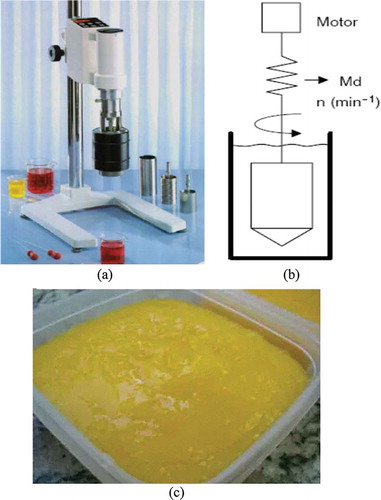
Methods
Before beginning the experiment, the pulp samples (see ) were thawed slowly under refrigeration temperature, 4–8ºC, in order to minimize the amount of drip and thus ensure that the rheological properties were similar to the non-frozen product. After thawing of the pulp, it was homogenized with a piston high-pressure homogenizer. Then it was heated using a thermostatic temperature control system until each sample reached the pre-established temperatures of 20°C, 30°C, or 40°C. Five replicates of the experiment were performed at each temperature. The deformation rate, , varied from 0.1 to 400 s−Citation1, and 40 deformation points were obtained for each studied temperature. For the shear stress data,
, the average of the experimental points obtained in five replicates at each analysed temperature was used, corresponding to the range of shear rates predefined for the experiment. The deformation points were generated at 30 s intervals.
The operating principle of the rotational rheometer used in the experiment consists of placing the sample in the annular space between the inner and outer cylinders of the device. The rotor is set to a predefined speed (n). The sample then exerts resistance to the rotational motion due to its viscosity, which becomes apparent as a torque value (Md) is applied to the rheometer shaft, as illustrated in Fig. 1c.
Results and discussion
Rheograms
The rheograms of mango pulp at temperatures of 20°C, 30°C, and 40°C were obtained from the average shear stress values in five replicates at each analysed temperature, as shown in . The experimental rheograms showed the expected behaviour of pulp and fruit purees, as observed by[Citation30] studying the rheological behaviour of mango pulp. These biological materials exhibit a pseudoplastic behaviour, sometimes with initial tension, as reported by[Citation9] and[Citation31] for guava pulp. The curves in suggest that mango pulp has a pseudoplastic behaviour with initial tension, since the points do not begin at the origin, according to the results obtained by.[Citation9] In , it is observed that the slopes of the flow curves decrease with increasing shear rate, thus confirming the decrease of apparent viscosity with increasing shear rate. For the shear rate range of 250–300 s−Citation1 some oscillations were observed in the experimental rheograms. This behaviour was probably due to excessive sample volume during the experimental tests. In , also note that the shear stresses gradually decrease with increasing temperature. In fact, at higher temperatures, the resistance to flow of the fluid decreases with decreasing viscosity, thus resulting in lower torque values in the shaft of the rheometer and consequently lower shear stress values.
Sensitivity coefficient analysis
The sensitivity analysis revealed the influence of parameters,
, and
on the shear stress calculated by the direct model (Eq. 3) and indicated that these three parameters can be estimated simultaneously. a, b, and c shows the normalized sensitivity coefficients (
,
, and
) of shear stress (Eqs. 6–8) with respect to parameters
,
, and
. The temperatures adopted were 20°C, 30ºC, and 40°C, respectively. It was found that the rheological parameter most sensitive to the mathematical model is
, meaning that it is more easily estimated by the inverse methods. On the other hand, the parameter that showed the lowest sensitivity coefficient was
. According to Pelegrine et al.,[Citation23] it is difficult to determine
conventionally using a rheometer. This parameter is traditionally determined by fitting the mathematical model to experimental data.
An analysis of indicates that the sensitivity coefficients pertaining to and
show a similar behaviour. This indicates a possible linear dependence between these two parameters. According to Beck and Arnoud,[Citation15] a linear interdependence between two parameters prevents them from being estimated simultaneously, because a change in one parameter or the other causes the same effect on the theoretical response of the direct model.
illustrates the ratio between the normalized sensitivity coefficients for the three parameters of the rheological model. These figures show that the resulting curve of the ratio of the normalized sensitivity coefficients ofand
(
/
) is approximately constant at about 100 s−Citation1 and 400 s−Citation1, thus confirming that there is a linear interdependence between
and
in most of the shear rate range. Therefore, these two parameters cannot be estimated simultaneously.
Inverse problem analysis
The analysis of the sensitivity coefficient indicates thatand
can probably be estimated simultaneously. Therefore, the inverse problem here consists in determining these two parameters of mango pulp based on a rheological experiment. The
will be considered to be known a priori, since its values were determined experimentally by[Citation31] at the temperatures of 20ºC, 30ºC, and 40ºC. Because the fluid in question presents a pseudoplastic behaviour, as found for mango pulp,[Citation31] it is known that the exact variation of
ranges from 0 to 1.
lists the values of and
estimated for mango pulp by the solution of the inverse problem (the Levenberg–Marquardt method, Eq. 10), with their respective confidence intervals (Eq. 13). The Levenberg–Marquardt method considers the confidence level of each experimental point used in the estimation, thus enabling one to define the confidence interval of the parameters, which ensures more reliable results. The confidence intervals are in the order of 10–Citation3, which is considered satisfactory, since the estimated values presented a variation of only 0.019% around its average value. The low levels of uncertainty also confirm the efficiency and accuracy of the estimation.
Table 1 Rheological parameters estimated by the Levenberg–Marquardt method.
a, b, and c shows the behaviour of the flow curves of the mango pulp obtained experimentally (), and also calculated by the Mizrahi–Berk equation (Eq. 3), using the parameters estimated by the Levenberg–Marquardt method () at the temperatures of 20°C, 30°C, and 40°C. The figures show a good consistency between the experimental and theoretical curves, and also indicate that the residuals between the experimental and theoretical values are quite small. Note that the residual points are distributed relatively randomly around zero: 0.0253, 0.0435, and 0.0789 Pa for the curves of 20ºC, 30ºC, and 40ºC, respectively. Thus, it can be concluded that the methodology proposed here serves to estimate the rheological parameters.
Conclusions
An inverse problem is solved to estimate the rheological parameters of mango pulp. The direct problem was solved using the Mizrahi–Berk theoretical model, while the problem of nonlinear minimization of squared differences to identify the parameters was solved by the Levenberg–Marquardt iterative method. A sensitivity analysis of the direct model for the rheological parameters was performed. This analysis indicated which parameters can be estimated from experimental data. The rheological parameters ofand
were estimated at the temperatures of 20°C, 30°C, and 40°C with a small confidence interval. Good consistency was fund between the experimental and theoretical shear rate versus shear stress curves. The residual curves between the experimental and theoretical values were small, in other words 0.0253, 0.0435, and 0.0789 Pa for the curves of 20ºC, 30ºC, and 40ºC, respectively. The knowledge of the rheological behaviour of the materials has its importance due to the physical aspects related to the deformation and flow in the food processing industry. In this context, the inverse method proposed in this work appears as a valuable tool capable of simultaneously estimating the rheological parameters of fruit pulp.
Nomenclature
| = | consistency index (Pa.sn) | |
| = | Mizrahi–Berk square root of yield stress (Pa)1/2 | |
| = | Mizrahi–Berk consistency index (Pa1/2. | |
| = | fluid behaviour index (dimensionless) | |
| = | Mizrahi–Berk fluid behaviour index (dimensionless) | |
| = | sensitivity coefficient matrix (Jacobian matrix) | |
| S | = | objective function |
| Z | = | shear stress vector |
| I | = | number of measurements |
| Greek symbols | = | |
| = | shear stress (Pa) | |
| = | initial shear stress (Pa) | |
| = | shear rate (s−1) | |
| = | plastic viscosity (Pa.s) | |
| = | vector of unknown parameters | |
| = | damper parameter | |
| = | diagonal matrix | |
| = | small number for convergence | |
| = | error convergence | |
| = | vector of standard deviation of the parameters | |
| Subscripts | = | |
| OLS | = | ordinary least squares |
| i | = | number of parameters |
| Superscripts | = | |
| * | = | normalized |
| k | = | number of iterations |
| T | = | transposed |
| est | = | estimated |
Acknowledgments
The authors thank CEAR/UFPB – Brazil (Center of Alternative and Renewable Energy/Federal University of Paraíba - Brazil) for their support of this work.
References
- Gomes, R.G.; Penna, A.L.B. Características Reológicas e Sensoriais de Bebidas Lácteas Funcionais. Semina: Ciências Agrárias. Londrina 2009, 30, 629–646.
- Welti-Chanes, J.; Barbosa-Cánovas, G.V.; Aguilera, J.M. Engineering and Food for the 21st Century. CRC Press: Boca Raton, Flórida, United States, 2002.
- Ünal, B.; Metin, S.; Isikli, N.D. Use of Response Surface Methodology to Describe the Combined Effect of Storage Time, Locust Bean Gum and Dry Matter of Milk on the Physical Properties of Low-fat Set Yoghurt. International Dairy Journal 2003, 13, 909–916.
- Marcotte, M.; Hoshahili, A.R.T.; Ramaswamy, H.S. Rheological Properties of Selected Hydrocolloids as a Function of Concentration and Temperature. Food Research International 2001, 34, 695–703.
- Rao, M.A.; Rizvi, S.S.H.; Datta, A.K.; Ahmed, J. Engineering Properties of Foods; CRC Press: Boca Raton, Flórida, United States, 2nd ed. 1994.
- Faraoni, A.S.; Ramos, A.M.; Guedes, D.B.; Moacir, M.R.; Pinto, R. Propriedades Reológicas de Sucos Mistos de Manga, Goiaba e Acerola Adicionados de Fitoquímicos. Brazilian Journal Food Technololy, Campinas 2013, 16, 21–28.
- Vidal, J.R.M.B.; Pelegrine, D.H.; Gasparetto, C.A. Efeito da Temperatura no Comportamento Reológico da Polpa de Manga (Mangífera Indica L-Keitt). Campinas 2004, 24, 39–42.
- Vidal, J.R.M.B.; Gasparetto, C.A.; Grandim, A. Efeito do Comportamento Reológico da Polpa de Manga. Revista Ciências Exatas e Naturais 2000, 1, 69–76.
- Ferreira, G.M.; Queiroz, A.J.M.; Conceição, R.S.; Gasparetto, C.A. Efeito da Temperatura no Comportamento Reológico das Polpas de Caju e Goiaba. Revista Ciências Exatas e Naturais 2002, 4, 176–184.
- Vidal, J.R.M.B.; Sierakowski, M.R.; Haminiuk, C.W.I.; Masson, M.L. Propriedades Reológicas da Polpa de Manga Centrifugada. Revista Ciênciasagrotécnicas, Lavras 2006, 30, 955–960.
- Cabral, M.F.P.; Queiroz, A.J.M.; Figueirêdo, R.M.F. Comportamento Reológico da Polpa de Cupuaçu Peneirada. Revista Brasileira de Produtos Agroindustriais 2002, 4, 37–40.
- Balischi, L.; Pereira, N.C.; Lima, O.C.M.; Barros, S.T.D.; Damasceno, J.W.; Mendes, E.S. Influência do Tratamento Enzimático sobre as Características Reológicas e Microscópicas da Polpa de Acerola. Acta Scientiarum, Maringá 2002, 24, 1649–1658.
- Vissoto, Z.; et al. Caracterização Físico-Química e Reológica de Chocolates Comerciais Tipo Cobertura e Elaborados com Gorduras Alternativas. Brazilian Journal of Food Technology 1999, 20, 139–148.
- Silva, C.K.F.; Souza, M.A.P.; Silva, Z.E.; Mariani, V.C. In Comparativo dos Métodos de Otimização na Estimativa da Difusividade Efetiva de Massa de Cogumelos via Problema Inverso, National Congress of Mechanical Engineering. CONEM, Bahia, Brazil. Paper CON08-0430, August 25–28, 2008.
- Beck, J.V.; Arnoud, K.J. Parameter Estimation in Engineering and Science; John Wiley and sons: New York, United States, 1977.
- Trujillo, D.M.; Busby, H.R. Practical Inverse Analysis in Engineering; CRC Press: New York, Boca Raton, Flórida, United States, 1997; 256 pp.
- Silva, C.K.; Oliveira, A.S.S.; Kurozawa, L.E.; Murr, F.E.X.; Silva, Z.E. CITT and Inverse Analyses Applied to the Study of the Mushroom Drying Process. Journal of Food Engineering 2010, 101, 166–178.
- Silva, C.K.; Silva, Z.E.; Mariani, V.C. Determination of the Diffusion Coefficient of Dry Mushrooms Using the Inverse Method. Journal of Food Engineering 2009, 95, 1–10.
- Monteau, J.-Y.; Estimation of Thermal Conductivity of Sandwich Bread Using an Inverse Method. Journal of Food Engineering 2008, 85, 132–140.
- Silva, C.K.F.; Aplicação da Análise Inversa ao Modelo Difusional de Transferência de Massa. Dissertação – Mestrado, UFPB, João Pessoa, PB, 2007.
- Sengul, M.; Ertugay, M.F.; Sengul, M. Rheological, Physical and Chemical Characteristics of Mulberry Pekmez. Food Control 2005, 16, 73–76.
- Holdsworth, S.D.; Applicability of Rheological Models to the Interpretation of Flow and Processing Behavior of Fluid Food Products. Journal of Texture Studies 1971, 2, 393–418.
- Pelegrine, D.H.; Vidal, J.R.M.B.; Gasparetto, C.A. Efeito da Viscosidade Aparente das Polpas de Manga e Abacaxi; Revista Ciência e Tecnologia de Alimentos: Campinas, SP, 2000; 20 pp.
- Silva, C.K.F.; et al. Problema Inverso de Difusão de Massa: Estimação da Difusividade Mássica do Tomate Cereja. Brazilian Congress of Thermal Sciences and Engineering – ENCIT. Curitiba, Brazil. Paper CIT06-0620, Deember 5–8, 2006.
- Liu, G.H.; Han, X. Computational Inverse Techniques in Nondestructive Evaluation; CRC Press: New York, United States, 2003; 592 pp.
- Ozisik, M.N.; Orlande, H.R.B. Inverse Heat Transfert; Taylor & Francis: NY, United States, 2000; 330 pp.
- Aster, R.C.; Borchers, B.; Thurber, C.H. Parameter Estimations and Inverse Problems; Elsevier: San Diego, California, United States, 2005; 301 pp.
- Bezerra, J.R.M.V.; Queiroz, A.J.M.; Gasparetto, C.A. Reologia de Polpa de Manga e Ajuste dos Parâmetros Reológicos em Função da Temperatura. Revista Brasileira de Produtos Agroindustriais. Brazil 2001, 3, 37–42.
- Scremin, F.F.; Influência do Estado de Maturação e das Etapas de Processamento na Reologia e Caracterização Físico-Química da Polpa de Goiaba (Psidium Guajava, L) Pasteurizada. Dissertação –Mestrado, UFSC, Florianópolis, SC, Brazil, 2007.
- Machado, J.C.; Reologia e Escoamento de Fluidos: Ênfase na Indústria do Petróleo; Ed. Interciência: Rio de Janeiro, Brazil, 2002.
- Sato, A.C.K.; Influência do Tamanho de Partículas no Comportamento Reológico de Polpa de Jabuticaba. Dissertação – Mestrado. UNICAMP, Campinas, SP, 2005.

